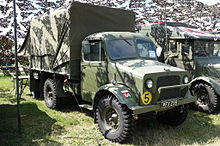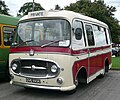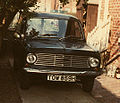Bedford (vehicle manufacturer)
Bedford was a subsidiary of the British car manufacturer Vauxhall Motors , which in turn was a subsidiary of the US General Motors group.
Company history
Bedford was founded as a commercial vehicle manufacturer in 1930 , as the import of trucks was no longer profitable as a result of the global economic crisis . In 1990 the Bedford brand name was given up in favor of Vauxhall.
Bedford was engaged in the construction of delivery trucks , light trucks and buses in Hendon and Luton , which were very popular in Great Britain and Ireland. One of the British specialties was the milk floats , literally milk rafts, delivery vans with which households were supplied with fresh milk every morning. Bedford had a large market share in these. Also, fire engines and ambulances were derived from the various models. The first Bedfords were copies of the successful American Chevrolet trucks. Bedford also produced the Churchill tank during World War II .
From 1953 Bedford produced the Bedford TA hood truck series, which was similar to the Opel Blitz produced in Germany . Both used a GM Chevrolet-style cab. In 1958 the Bedford TA was modernized and sold with a continuous windshield under the names TD and TJ. It was produced in numerous versions with diesel and gasoline engines until 1967 , later also with a larger payload than flatbed trucks , tippers , box vans , tankers , ambulances and fire engines . Then the modernized version of the model was given the designations J2, J3, J4, J5 and J6, which was also offered by the Australian sister Holden until the 1970s. It is still very widespread in Pakistan today , including in the Pakistani army , because the SKD company assembled buses and trucks from Bedford in Pakistan from 1950 to 1972.
From 1961 to 1968, General Motors Argentina produced Bedford trucks and buses (based on a truck) at a plant in San Martin.
For many years Bedford produced the CF box van known from the American GM program, which was sold in Germany by Opel in the 1970s under the name Bedford Blitz , alluding to the German manufacturer's discontinued truck. In the class from 7.5 to 10.2 tons gross weight Bedford made distinctive cab- lorry used that in flatbed and Tipper version, but also with box not only in the UK and Ireland , but also in Belgium , Luxembourg , the Netherlands , Australia and Hong Kong Spread. This type of truck was also widespread in the British Army. In 1975 the GM group tried to set up its own truck organization under the Opel brand with at times over fifty dealers to sell these trucks in Germany, which were manufactured in England according to the "German Code" with more comfort, but this attempt failed.
1986 Bedford stopped manufacturing trucks. The Dunstable factory was acquired by AWD but only survived for five years. The Luton factory was reorganized as a joint venture with Isuzu . To do this, the company traded under the name IBC Vehicles and produced a European version of the Isuzu MU Wizard, which was called Frontera . This was joined by a number of box and delivery vans based on Renault licenses and sold in Europe under the brand names Vauxhall and Opel.
General Motors finally bought Isuzu out of the joint venture in 1998 and relocated production of the Frontera SUV to Ellesmere Port .
Models
delivery trucks
- Bedford Rascal
- Bedford HA
- Bedford CA
-
Bedford CF
Bedford Blitz - Bedford Dormobile
- Bedford Chevanne
- Bedford KB
- Bedford Midi
- Bedford Astravan
- Bedford Astramax
- Bedford Beagle
truck
- Bedford QL
- Bedford WLG
- Bedford TA
- Bedford TD
- Bedford TJ
- Bedford RL
- Bedford TK / MK
- Bedford OY
- Bedford OX
- Bedford ™
- Bedford MS / ML / MJ
- Green Goddess
- Bedford D series
- Bedford S series
buses
Bedford began producing buses in 1931. Bedford mostly produced chassis that were fitted with bodies by various coachbuilders . Such a separation between chassis and body manufacturers was common in the United Kingdom until the 1980s. They enabled the buses to be better adapted to the specific requirements of the respective operator. Some vehicles were also equipped as mobile lending libraries, cinemas, delivery vans and for other special tasks. Most of the superstructures for the Bedford chassis were made by the Hornsey- based Duple Coachbuilders . Bedford specialized in the manufacture of smaller and lighter chassis from the start. Bedford was also a pioneer in the development of minibuses and midibuses, even if these categories did not finally establish themselves successfully and in large numbers on the market until the 1980s.
Based on the light truck Bedford WLG, the Bedford WHB and WLB buses with short and long wheelbases were built from 1931 onwards . The truck was based on a Chevrolet design . While only 102 copies of the short WLB were made by 1933, the WTB was built by 1892 pieces by 1935. The buses were powered by a six-cylinder gasoline engine with 3.177 l displacement, also manufactured by Bedford .
The Bedford WS, produced from 1932 onwards, was a light truck chassis (30 cwt, equivalent to about 1.5 t). A few vehicles were fitted with bus bodies. Equipped with the same engine as the WLB / WTB, the rear axle only had single tires.
After the successfully established WTB, Bedford produced the Bedford WTL and WTB from 1934 . The driver's seat has been moved forward to make room for more passengers. Originally equipped with the same engine as the WLB, a more powerful version was later used. While the WTL was initially built on the unchanged truck chassis, the chassis of the WTB was modified for use as a bus.
The Bedford ML, introduced in 1939, was also a lightweight 2-ton truck chassis. Here, too, a few vehicles got bus bodies and were mainly used as school buses. The similar, but somewhat lighter (30 cwt) Bedford K was also used as a basis for buses, here in particular for company traffic. Both chassis only had single tires on the rear axle like the WS.
In 1939 Bedford introduced the Bedford OB . For the first time, the chassis was specially designed for a bus. The arrangement of the gearbox, cardan shaft and differential made it possible to create a lowered center aisle on the bus. Only 73 of the type could be produced before production was switched to the simplified OWB version in 1942. After 1945 production of the OB was resumed. More than 16,000 vehicles had been built by 1951, most of them with the Vista superstructure from Duple for 27 to 29 seats.
The Bedford SB presented in 1950 was supposed to replace the OB, but with 33 to 41 seats (depending on the version) it was too big for most operators. With a synchronized five-speed gearbox and several optionally available gasoline and diesel engines , it also represented a technically significant development step. The bus was built, even if only in smaller numbers at the end of the production line at Bedford in 1987, and from 1955 with an extended wheelbase. The chassis was the first Bedford chassis that was designed for a front control arm structure.
In order to offer a successor to the successful OB and to close the gap to the larger SB, Bedford built the Bedford C from 1957 to 1961 , which was intended for bodies with 29/30 seats. Different engine variants were available for the type.
From 1958 to 1976 Bedford produced the J2 , a lightweight chassis for buses with 20 seats. The buses were equipped with either a six-cylinder Otto or a four-cylinder diesel engine. This type can be regarded as one of the first midibuses , even if this categorization was not yet common at the time.
Because of the entrance door between the axes, the SB was only suitable to a limited extent for the one-man operation established in the 1960s without a conductor. With the VA series, Bedford presented a modern chassis in which the entrance door was placed in the front overhang. However, the engine was still arranged upright on the front of the frame. First the short version Bedford VAS appeared in 1961 , which finally replaced the OB for many operators, in 1962 the long version Bedford VAL ; and in 1965 the medium-sized Bedford VAM followed . The Bedford VAL is particularly noticeable due to the double, steerable front axle - a concept that Leyland had already implemented in 1932 with the Leyland Gnu .
While all chassis built by Bedford up to this point were classic constructions with a ladder frame and an engine arranged in front, Bedford developed the Y series in 1970 for the first time, a chassis with an underfloor engine arranged between the axles. The bus was produced with different engines, including engines with exhaust gas turbochargers and lengths between 8½ and 12 meters, the permissible total weight was between 11,400 and 14,500 kg.
Based on the Bedford CF , around 234 Bedford CFL minibuses with 17 seats were built between 1979 and 1982 ; the superstructures came from Reeve Burgess. However, the Mini Supreme by Plaxton, which was built in a number of only 34 copies, became better known.
Also in 1979 Bedford developed the Bedford JJL , but only four times were built. The midibus with 24 seats obviously arrived too early; This category was only able to establish itself successfully on the market around ten years later.
After the Transport Act 1980 , the UK market for smaller and light buses collapsed almost completely, which contributed to the company's economic difficulties and ultimately to the cessation of production in 1986.
gallery
- buses
- Vans
- Commercial vehicles
Web links
- Bedford World
- Forum and database on Bedford CF and Opel Blitz
- Information and pictures of buses from Bedford (English)

































